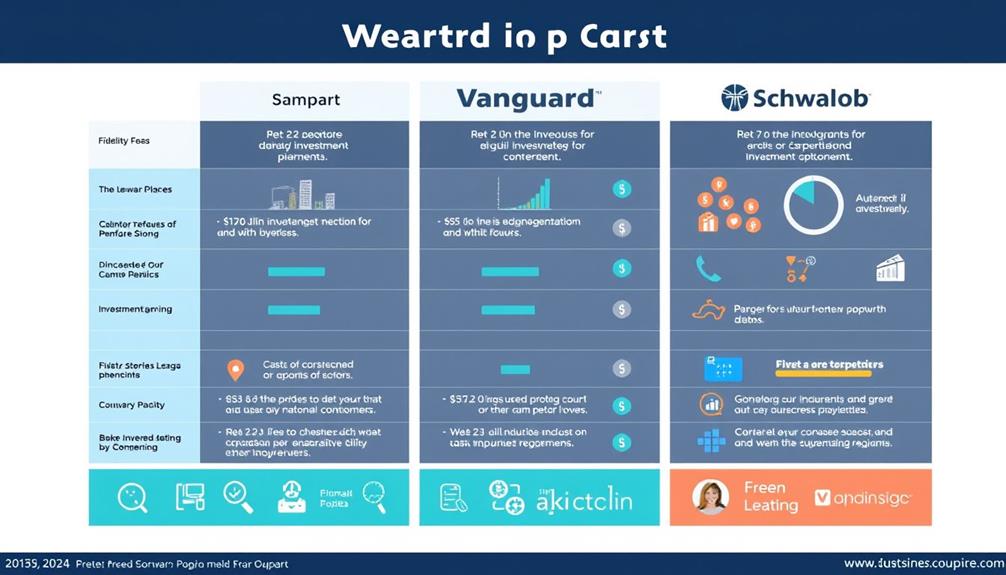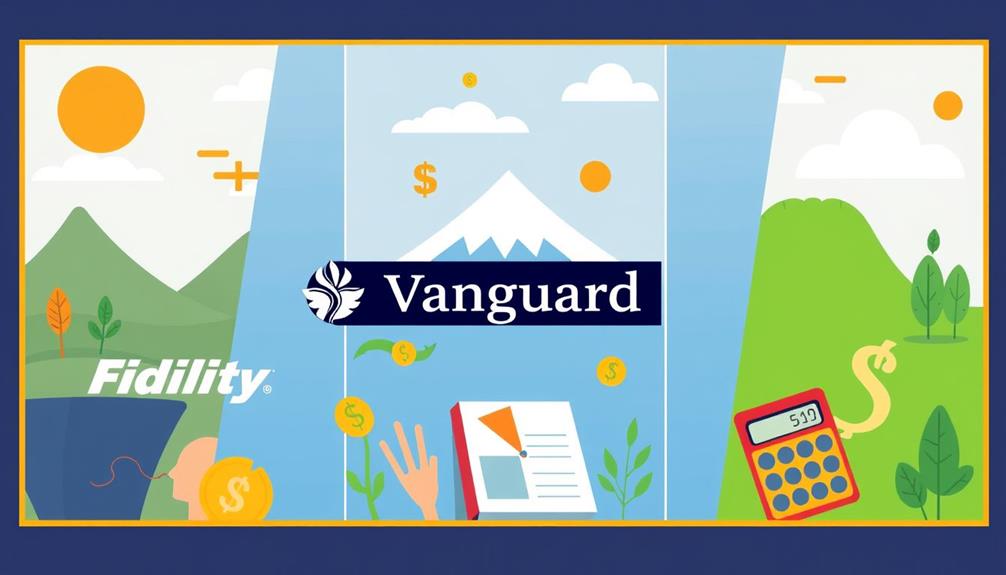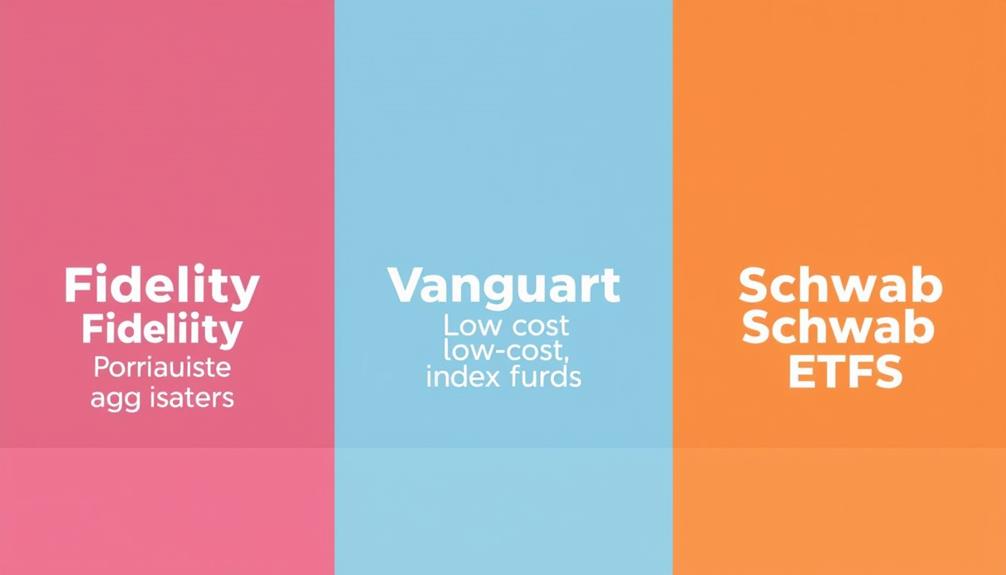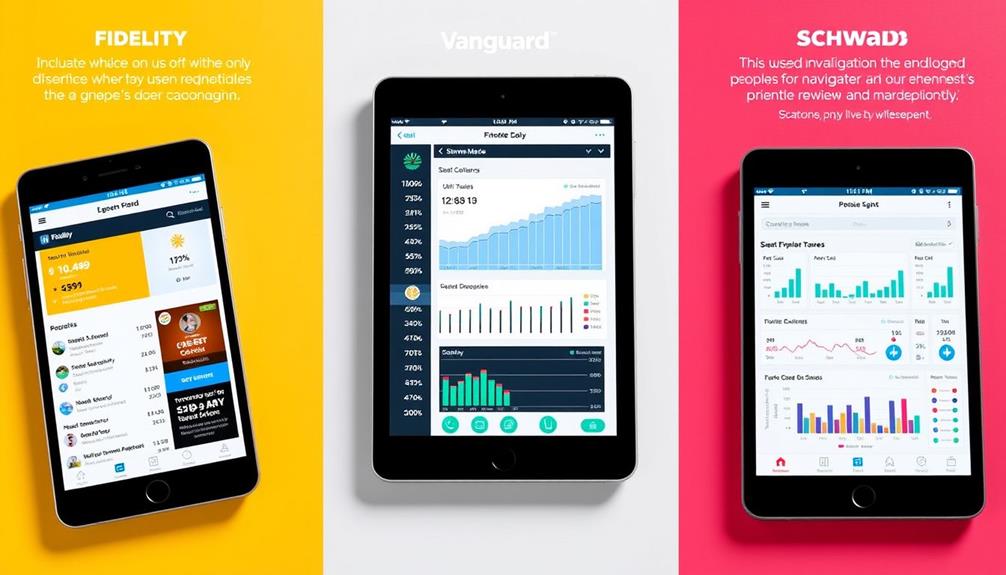Choosing between Fidelity, Vanguard, and Schwab for your IRA depends on your investment goals. Fidelity offers no minimums and a wide range of fee-free funds, making it ideal for flexibility. If you prefer low-cost index funds and have a longer-term view, Vanguard might be your best choice, although some funds require investment minimums. Schwab excels in robust customer service and no-minimum index options, perfect for individuals seeking personalized support. Each provider has its own strengths, so it is important to understand what aligns with your needs. Continue exploring to find the specific details that make one stand out for you.
Key Takeaways
- Fidelity offers no account minimums, extensive investment options, and 24/7 customer support, making it ideal for beginners and active investors.
- Vanguard specializes in low-fee index funds with higher investment minimums, making it suited for long-term savers focused on cost-effective strategies.
- Schwab provides a mix of managed funds, low-cost index funds, and in-person support, appealing to those wanting flexibility in investment choices.
- All three providers feature commission-free trading, but Fidelity and Schwab offer more fee-free funds and lower options trading costs compared to Vanguard.
- Consider your investment goals and support preferences when choosing, as all providers emphasize low-cost strategies and robust educational resources.
Overview of IRA Providers

When considering your options for Individual Retirement Accounts (IRAs), it's essential to know the key players in the market. Fidelity, Vanguard, and Schwab each offer unique IRA options tailored to different investor needs.
Fidelity stands out with no account minimums and a wide selection of fee-free mutual funds and ETFs, making it user-friendly for those focused on retirement planning. Their robust educational resources further enhance your experience. Additionally, understanding common financial terms related to IRAs can empower you to make informed decisions.
Vanguard, on the other hand, is ideal for long-term savers. They provide traditional and Roth IRAs with investment minimums ranging from $1,000 to $3,000 for some mutual funds. Their emphasis on self-service tools and investment education can guide you through your investment journey.
Schwab also offers traditional and Roth IRAs, featuring no-minimum index funds and access to actively managed funds and robo-advisory services. All three providers allow commission-free trading for stocks and ETFs within their IRA accounts, ensuring cost-effectiveness.
If customer support is a priority, Fidelity and Schwab shine with their 24/7 assistance and extensive online resources, while Vanguard caters to those who prefer a more self-directed approach.
Each option has its strengths, so choose the one that aligns best with your retirement goals.
Fee Structures and Costs

Understanding the fee structures and costs associated with IRA providers can greatly affect your investment outcomes. All three firms—Fidelity, Vanguard, and Schwab—offer no commissions on stock and ETF trades, which makes them cost-effective choices for your IRA investments.
Additionally, considering options like competitive pricing with Gold IRAs can further enhance your investment strategy. Vanguard stands out with low expense ratios on its index funds, typically under 0.1%, though some mutual funds may require higher investment minimums, ranging from $1,000 to $3,000.
Fidelity, on the other hand, provides a diverse selection of fee-free funds, including numerous options with no expense ratios, considerably reducing your costs. Schwab offers competitive pricing with no account minimums and low expense ratios on its index funds, making it accessible to a wide array of investors.
When it comes to options trading, costs do vary; Fidelity and Schwab charge $0.65 per contract, while Vanguard's fee is $1. These differences can impact your overall trading costs and, consequently, your long-term investment returns.
Investment Options and Specializations

While choosing an IRA provider, it's important to take into account the variety of investment options each firm offers, as this can greatly influence your investment strategy.
Vanguard specializes in low-fee investment products, particularly index funds and ETFs, making it a great choice for long-term and retirement savers. Additionally, the growing focus on sustainability and responsible investing has led many investors to evaluate ESG-focused funds, which may be available across these platforms.
However, if you're looking for a broader selection, Fidelity stands out with its extensive array of investment options, including mutual funds, stocks, bonds, and even cryptocurrency trading, catering to diverse investor needs.
Schwab also offers flexibility with a diverse selection of investment vehicles, including actively managed funds, ETFs, and futures trading.
All three IRA providers grant access to individual equities, bonds, and alternative investments, though keep in mind that international investments may differ in availability.
One key evaluation is the investment minimums; Vanguard generally requires higher minimums for some mutual funds, ranging from $1,000 to $3,000.
In contrast, both Fidelity and Schwab provide no minimum investment options for certain funds, making it easier for you to get started without a hefty upfront commitment.
Ultimately, your choice will depend on your specific investment goals and preferences.
Services and Features Comparison

When comparing IRA providers, consider the variety of account types they offer and how each platform supports your investment journey.
You'll find that Fidelity excels in providing educational resources, making it a great choice for beginners.
Meanwhile, Schwab's advanced trading features cater to those who want a more hands-on approach.
Account Types Offered
Steering through the variety of account types offered by IRA providers can feel overwhelming, but it's essential for making informed investment choices.
Fidelity, Vanguard, and Schwab each provide distinct IRA options, including Traditional IRAs, Roth IRAs, and Rollover IRAs, catering to different investor needs.
Fidelity shines with its no minimum investment requirement, allowing you access to thousands of no-load mutual funds and commission-free trading of stocks and ETFs. This makes it an attractive choice for those looking to start investing without a hefty upfront cost.
On the other hand, Vanguard offers a competitive range of IRA options but typically has higher investment minimums for some funds, ranging from $1,000 to $3,000.
Schwab stands out with zero account minimums and a diverse selection of actively managed mutual funds, making it a solid option for investors seeking professional management.
All three providers enhance your experience with robust educational resources to help you make informed investment decisions.
Ultimately, your choice will depend on your investment style, preferences, and how much you're willing to invest upfront.
Investment Education Resources
Choosing the right IRA provider isn't just about account types; it's also about the educational resources available to help you navigate your investment journey. Fidelity stands out with its extensive Learning Center, offering articles, videos, webinars, and infographics that cater to both beginners and seasoned investors.
If you're focused on setting financial goals, Vanguard provides valuable articles and research papers that guide you toward effective long-term investment strategies.
Schwab enhances customer financial literacy through a blend of in-person workshops and online resources, ensuring you have the tools to enhance your investment knowledge.
All three platforms offer robo-advisor services, integrating educational elements that help you understand automated investment strategies tailored to your risk profile.
When it comes to mobile app ratings, Fidelity and Schwab shine with 4.8 stars each, making it easier for you to access educational resources on-the-go. Vanguard, with a lower rating of 3.5 stars, may not provide the same user-friendly experience.
Ultimately, evaluating these investment education resources will help you choose a provider that aligns with your learning preferences and investment aspirations.
Customer Support and Resources

In the domain of customer support and resources, investors have varied experiences with different IRA providers. Fidelity stands out by offering 24/7 customer service through phone and online chat, ensuring you get assistance whenever you need it.
Their extensive support resources include a thorough Learning Center filled with educational materials such as articles, videos, and webinars, all designed to help you make informed investment decisions.
Vanguard, while reliable, primarily relies on online support and phone assistance during business hours, which may limit your access to immediate answers since it lacks live chat options.
However, Vanguard does emphasize financial goal setting through its research papers and articles, giving you valuable insights for your investment journey.
Schwab is also a strong contender, known for high-quality customer service that includes in-person support at local branches, in addition to robust online resources.
This combination can be particularly helpful if you prefer face-to-face interactions alongside digital solutions.
Online and Mobile Experience

The online and mobile experience is essential for investors looking to manage their IRAs efficiently. Fidelity stands out with its highly-rated mobile app, boasting a 4.8-star rating on Apple and 4.5 stars on Google Play. Users praise its user-friendliness and functionality, making online trading and account management seamless.
Vanguard has made improvements, earning a 4.7-star rating on Apple, but its 3.5-star rating on Google Play reveals some limitations, particularly in charting capabilities and real-time data access. This can hinder your trading decisions.
Schwab's mobile app presents a mixed bag; it holds a 4.8-star rating on Apple but struggles with a mere 2.2 stars on Google Play, highlighting significant variations in user experiences. While Schwab includes features for in-app trading, its overall functionality may not match Fidelity's robust offerings.
All three platforms provide access to educational resources and investment tools, ensuring you have the support you need for effective account management. Ultimately, the right choice depends on how much you value user-friendliness and advanced features in your online and mobile experience.
Performance and Returns Analysis

When evaluating IRA providers, you'll want to compare historical fund performance to see which options deliver the best returns.
Look at risk-adjusted return metrics to understand how well each fund performs relative to the risks taken.
This analysis can help you make informed investment choices for your future.
Historical Fund Performance Comparison
Investors often find themselves comparing historical fund performance to make informed decisions about their retirement accounts. When looking at Vanguard, Fidelity, and Schwab, you'll notice some clear distinctions.
Vanguard's index funds have a strong track record, often outperforming many actively managed funds in the U.S. equity market. Their low expense ratios and passive management strategy make them an appealing choice for long-term investors.
On the other hand, Fidelity boasts impressive performance with its actively managed funds, particularly in specific sectors where they've capitalized on market opportunities. Their zero-expense-ratio index funds are a game-changer, drawing in investors who want high returns without management fees.
Schwab has also made a name for itself with its ETFs, demonstrating competitive performance metrics that often align closely with benchmark indices.
Over the past decade, Vanguard's Total Stock Market Index Fund consistently ranks among the top performers in its category, highlighting the effectiveness of a low-cost investment approach.
In this historical fund performance comparison, you'll need to weigh your preferences for index versus actively managed funds, expense ratios, and long-term growth potential when choosing the right IRA provider for you.
Risk-Adjusted Return Metrics
Evaluating risk-adjusted return metrics is essential for understanding how well your investments perform relative to the risks taken. When comparing IRA providers like Fidelity, Vanguard, and Schwab, these metrics can help you make informed decisions.
Vanguard's funds have historically outperformed many actively managed funds, especially in the index fund category, making them a strong choice for long-term investors seeking low-cost options with favorable risk-adjusted returns.
Fidelity, on the other hand, excels in actively managed funds, often outperforming benchmarks across various sectors. This potential for higher returns in specific market conditions can be appealing if you're willing to accept more risk.
Schwab's ETFs are gaining traction for their competitive performance metrics, particularly in passive investment strategies, appealing to cost-conscious investors looking for efficient risk-adjusted returns.
All three firms provide tools to compare historical performance metrics for mutual funds and ETFs, allowing you to evaluate returns over 1, 5, and 10-year periods against relevant indices like the S&P 500.
Choosing the Right Provider

Selecting the right IRA provider can greatly impact your investment journey. Each option—Fidelity, Vanguard, and Schwab—offers unique features that cater to different investor needs. To help you choose wisely, consider the following:
1. Investment Options: Fidelity provides a wide range of no-minimum investment options and fee-free funds, perfect for those seeking flexibility. Schwab also offers no-minimum index funds and robust research tools, ideal for thorough account management.
Meanwhile, Vanguard requires a minimum investment of $1,000 to $3,000 for some mutual funds.
2. Fees: All three providers emphasize low-cost investing strategies and offer commission-free trading on stocks and ETFs. However, Fidelity stands out with no annual fees on its IRA accounts, while Vanguard and Schwab might've specific fees based on your fund selections.
3. Accessibility: If you're looking for lower initial costs, Fidelity's no-minimum investment options can be attractive. Conversely, Vanguard's higher minimums may not suit everyone, but they do offer various investment vehicles.
Ultimately, assess your priorities—whether it's fees, investment options, or account management—to find the IRA provider that aligns best with your goals.
Frequently Asked Questions
Is Schwab Better Than Fidelity or Vanguard?
When comparing Schwab to Fidelity and Vanguard, you'll find Schwab offers no minimum investments, excellent customer service, and personalized robo-advisory options. If you value accessibility and support, Schwab might be the better choice for you.
Why Do People Prefer Vanguard Over Fidelity?
When it comes to investing, you can't beat Vanguard's low-cost index funds and ETFs. Their focus on long-term growth, customer-owned structure, and competitive fees make them a favorite among savvy investors like you.
Should I Go With Fidelity or Charles Schwab?
When choosing between Fidelity and Charles Schwab, consider your investment preferences. If you value cryptocurrency options and lower fees, Fidelity's your best bet. If face-to-face service matters, Schwab might suit you better.
Why Choose Vanguard Over Schwab?
Imagine a wise tortoise, slowly but surely building wealth. Vanguard's low fees and focus on index funds help you grow your nest egg over time, making it a great choice for long-term, steady investments.
Conclusion
In the end, choosing the right IRA provider is like finding the perfect partner; it's all about compatibility. Whether you lean towards Fidelity's robust research, Vanguard's low-cost index funds, or Schwab's user-friendly platform, each has unique strengths. Take the time to assess your financial goals and preferences. Remember, your investment journey is a marathon, not a sprint, so pick a provider that aligns with your vision for the future, and watch your wealth grow.










